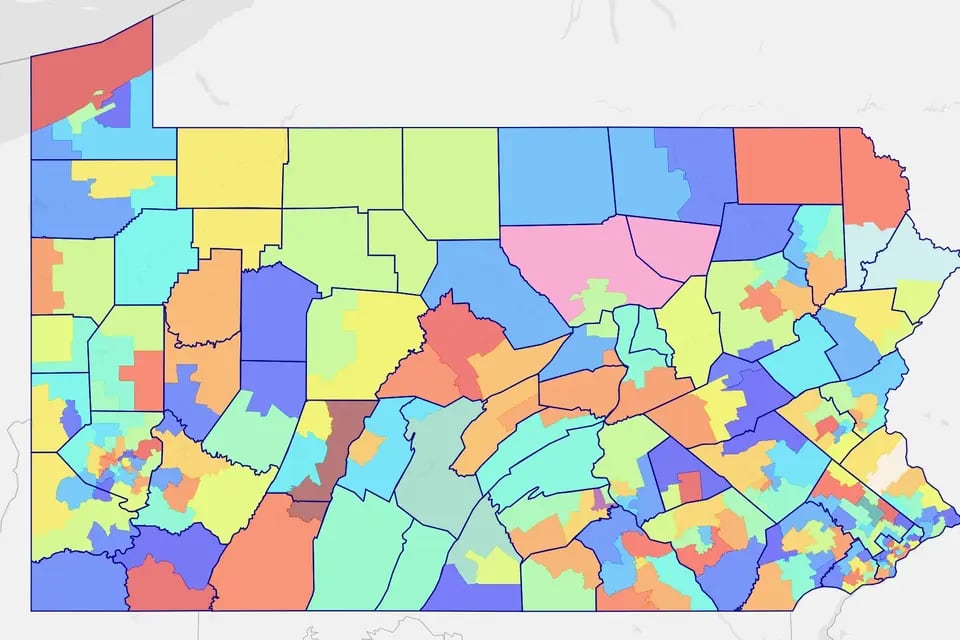This article is part of a yearlong reporting project focused on redistricting and gerrymandering in Pennsylvania. It is made possible by the support of Spotlight PA members and Votebeat, a project focused on election integrity and voting access.
HARRISBURG — A panel has approved a new Pennsylvania House map that meets the requirements laid out in the state constitution, while creating more districts that could be won by Democrats.
The Legislative Reapportionment Commission — a five-person panel composed of the top General Assembly leaders and an independent chair — voted 4-1 to approve both the state House and state Senate maps on Friday.
House Majority Leader Kerry Benninghoff (R., Centre) was the lone no vote, arguing that the creation of more Democratic-leaning seats in his chamber was done for political reasons. Data tests, however, show the map better reflects the partisan makeup of the state as well as population shifts over the past decade.
The process may not be over yet. Anyone can bring a challenge to either map to the state Supreme Court as part of a 30-day protest period that began Friday.
The Pennsylvania Constitution explicitly lists four requirements for state House and Senate districts: compactness, contiguity, minimal splits, and equal population. Here’s how the final map stacks up on those and other measures:
Compactness
Compactness looks at how close together all parts of a district are. It’s meant to prevent protrusions that would isolate some residents of a district. The Pennsylvania Constitution mandates that districts be compact, but it does not specify a metric or minimum threshold to measure districts.
The final House plan has an average level of compactness, scoring better than the current map on two commonly used metrics, the Polsby–Popper test and the Reock scale. Scored on a scale from 0 to 1, where 1 equals maximum compactness, the final plan hits 0.35 on the Polsby-Popper scale and 0.42 on the Reock scale. The current House map scores 0.27, and 0.36, respectively.
Contiguity
Contiguity means that there is no part of a district that is detached from the rest or completely isolated. A noncontiguous district looks like an archipelago. The final House plan fulfills this metric.
Split minimization
This metric is intended to keep communities together. Mapmakers aim to reduce county, municipal, and voting precinct splits, though most tend to focus on reducing the first two.
Compared to the current state House map, the final House plan reduces the number of county and municipality splits: 221 to 186, and 124 to 92, respectively.
Population equality
The Pennsylvania Constitution mandates that districts have the same number of residents. Per a U.S. Supreme Court case from the 1980s, the commonly accepted deviation from this standard is 10% for the overall map.
The overall population deviation of the final map is 8.65%.
Partisan fairness
The top Republican on the Legislative Reapportionment Commission has accused the panel of creating a partisan gerrymander in favor of Democrats. A look at various metrics shows the final map favors the GOP.
One such metric is proportionality, which looks at whether the likely results of elections in each district, based on past electoral data, would result in a group of elected officials that reflects the ratio of Democratic and Republican voters in the state.
Dave’s Redistricting App, a nonpartisan mapping website dedicated to creating and analyzing district maps, called the final map “Very Good” for proportionality, with a much smaller Republican lean than the current map.
Depending on which past election data is used, Dave’s Redistricting finds the likely number of Democratic seats would be 98. The number of Democratic seats that is closest to proportional is 102.
The Princeton Gerrymandering Project, another nonpartisan group that reviews district plans across the country, pegged the number of Democrat-leaning seats at 101 in an analysis for The Inquirer, compared to the current map’s 85.
Competitiveness
Competitiveness indicates how many districts have an even balance between Democratic and Republican voters, which minimizes one party dominating an area. Redistricting advocates argue that districts with this composition will be represented by legislators who are more responsive to voters, as their districts are less “safe.”
Dave’s Redistricting rated the map as less competitive, labeling only 13.91% of its districts as competitive compared to the current map’s 18.65%. Both are still a far cry from what Dave’s Redistricting calls a good level of competitive districts, around 75%.
Minority representation
Properly representing communities of color, which are driving Pennsylvania’s population growth, was a goal of high importance during the Legislative Reapportionment Commission’s meetings.
When possible, mapmakers aim to create majority-minority districts — those where the majority population is constituted by a minority group.
The final House plan scores better than the current map does on minority representation.
In total, there are 25 districts where either one minority community or a coalition of minority communities represent the population majority — the same as the current map.
But the proposed map also creates 19 districts with minority populations that are greater than 35%, creating a meaningful voting bloc, while the current map has only 13.
This story was adapted from previous Spotlight PA reporting.



